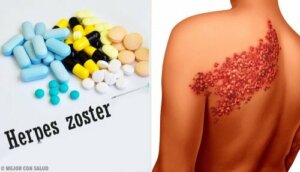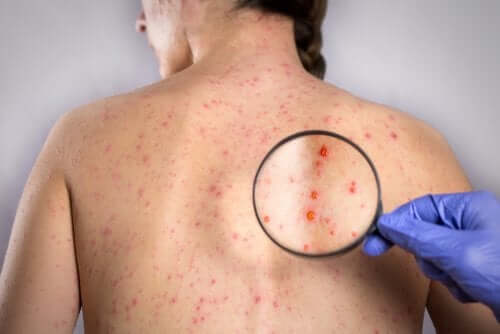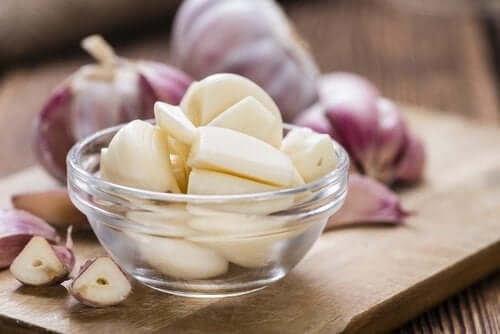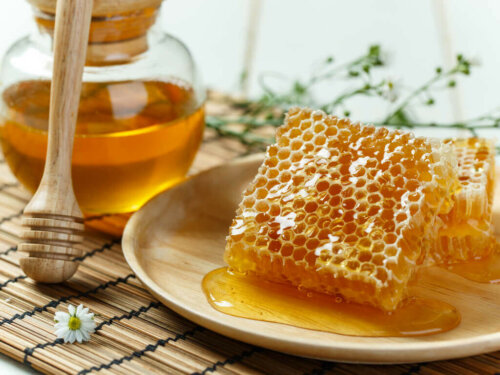Top 5 Remedies to Treat Shingles on the Back


Written and verified by the doctor Nelton Abdon Ramos Rojas
Shingles on the back aren’t only an aesthetic problem. In fact, this condition can have different causes and symptoms depending on the specific virus responsible for it. Thus, you must find out the type of herpes you have and treat it as soon as possible.
Some at the grassroots sector consider certain natural remedies effective against the discomfort caused by shingles on the back. Some of them include brewer’s yeast, aloe vera, and propolis.
More about shingles on the back

Herpes is an infectious disease caused by a virus. It is considered a chronic pathology, since this virus remains in our body and triggers outbreaks according to different factors.
The symptoms, the affected area, and the severity also vary according to the type of virus, which can be simple or zoster.
Both back herpes and any other variant appear in our body when your immune system is weak.
When it comes to treatment, Sociedad Española de Medicina Interna points out that:
- It’s not possible to eliminate the herpes zoster virus from the body through any form of treatment. However, certain medications can relieve or reduce the symptoms for faster recovery.
- Topical treatment on skin lesions can speed up the scabbing process and prevent discomfort and superinfections. Diluted zinc sulfate is best for this purpose.
Natural remedies for shingles on the back
Below we’ll share some of these remedies. However, we want to be clear in that these remedies should never replace medical treatment.
Remember that, although common, natural remedies aren’t always the most effective in all cases. Additionally, you must keep in mind that, if the doctor authorized its use, then the remedy could become a complement to treatment, within a healthy lifestyle.
According to the Mayo Clinic, one of the home remedies that can help get relief is the application of cold compresses on the blisters. They also indicate that, instead of applying compresses, you could take cold baths.
1. Echinacea
Echinacea is a plant with several attributes. It’s been used topically for treating ulcers, sores, and other conditions, such as back herpes.
Although there’s no scientific evidence of its anti-inflammatory, antibacterial, antiviral, and antiseptic properties of echinacea, some scientists think it has potential. However, they point out that it’s important to continue investigating and stay up to date.
Some believe an echinacea infusion can help “strengthen” the immune system and contribute to the treatment of the infection.
Others drink said infusion to relieve back herpes. However, there’s no proof that this beverage is responsible for any type of improvement.
A study published in 2010 concluded that some compounds in echinacea may be helpful in treating patients who have recurrent cold sores.
2. Brewer’s yeast
This substance contains lysine, one of the ten essential amino acids for humans. It’s also made up of other important nutrients, such as:
- Minerals and trace elements (such as selenium and chromium)
- Vitamins of the complex B like folic acid, biotin, and pantothenate
- Glutathione
- Fiber
Because of its lysine content, brewer’s yeast could help fight a herpes infection. For this reason, it’s recommended to add this food to one’s diet in order to benefit from all its properties and additionally, reinforce the immune system.
* Consult with your doctor before starting to consume brewers yeast in tablets or other similar forms.
Check out these 5 Interesting Home Remedies With Brewer’s Yeast
3. Garlic

Some people believe that garlic is a natural antibiotic due to its allicin content. Thsu, they also believe it can help reverse infections. However, there’s no proof that the consumption of garlic can provide such benefits.
Still, many people consume it regularly in their diet. Some even crush it and apply it as a poultice on wounds. However, dermatologists warn that this can irritate and worsen the condition.
4. Propolis
Another substance that many people consider a possible natural antibiotic is propolis. However, there’s no evidence sustaining this application or the claim that it can significantly contribute to the treatment of shingles on the back or any other infection.

5. Aloe vera
As it’s often attributed to having healing and anti-inflammatory properties, aloe vera is often recommended as a natural remedy for blisters caused by shingles on the back.
Furthermore, dermatologists don’t recommend using aloe vera in this way, as it can backfire. If you want to use it (or other remedies), run it by your doctor first.
Final note about shingles on the back
To treat back herpes properly, the best thing you can do is consult a doctor and follow their instructions. Additionally, maintain good lifestyle habits as these can contribute a lot to your health even if you’re healthy.
All cited sources were thoroughly reviewed by our team to ensure their quality, reliability, currency, and validity. The bibliography of this article was considered reliable and of academic or scientific accuracy.
- Cohen J (2013). Clinical practice: Herpes zoster. N Engl J Med, 369(3):255-63. Disponible en: https://pubmed.ncbi.nlm.nih.gov/23863052/
- Dworkin R, Johnson R, Breuer J, et al (2007). Recommendations for the management of herpes zoster. Clinical infectious diseases, 44:S1-S26. Disponible en: https://academic.oup.com/cid/article/44/Supplement_1/S1/334966
- Ghaemi A, Soleimanjahi H, Gill P, et al (2009). Echinacea purpurea polysaccharide reduces the latency rate in herpes simplex virus type-1 infections. Intervirology, 52(1):29-34. Disponible en: https://pubmed.ncbi.nlm.nih.gov/19372701/
- Griffith R, Walsh D, Myrmel K (1987). Success of L-lysine therapy in frequently recurrent herpes simplex infection. Treatment and prophylaxis, 175(4):183-90. Disponible en: https://pubmed.ncbi.nlm.nih.gov/3115841/
- Hudson J, Vimalanathan S (2011). Echinacea—A Source of Potent Antivirals for Respiratory Virus Infections. Pharmaceuticals (Basel), 4(7):1019–31. Disponible en: https://www.ncbi.nlm.nih.gov/pmc/articles/PMC4058675/
- Johnson R, Alvarez M, Bijl M, et al (2015). Herpes zoster epidemiology, management, and disease and economic burden in Europe: a multidisciplinary perspective. Ther Adv Vaccines, 3(4):109-20. Disponible en: https://www.ncbi.nlm.nih.gov/pmc/articles/PMC4591524/
- Mallick T, Snodgrass B, Brant J (2016). Postherpetic neuralgia: epidemiology, pathophysiology, and pain management pharmacology. J Multidiscip Healthc, 9:447-454. Disponible en: https://www.ncbi.nlm.nih.gov/pmc/articles/PMC5036669/
- Münstedt K (2019). Bee products and the treatment of blister-like lesions around the mouth, skin and genitalia caused by herpes viruses-A systematic review, 43:81-84. Disponible en: https://pubmed.ncbi.nlm.nih.gov/30935560/
- Nair P, Patel B (2022). Herpes Zoster. In: StatPearls [Internet]. Treasure Island (FL): StatPearls. Disponible en: https://www.ncbi.nlm.nih.gov/books/NBK441824/
- Rezazadeh F, Moshaverinia M, Motamedifar M, et al (2016). Assessment of Anti HSV-1 Activity of Aloe Vera Gel Extract: an In Vitro Study. J Dent (Shiraz), 17(1):49-54. Disponible en: https://www.ncbi.nlm.nih.gov/pmc/articles/PMC4771053/
- Sociedad Española de Medicina Interna (SEMI). Herpes Zóster. Disponible en: https://www.fesemi.org/informacion-pacientes/conozca-mejor-su-enfermedad/herpes-zoster
- Wang K, Coyle M, Mansu S, (2017). Gentiana scabra Bunge. Formula for Herpes Zoster: Biological Actions of Key Herbs and Systematic Review of Efficacy and Safety. Phytother Res, 31(3):375-386. Disponible en: https://pubmed.ncbi.nlm.nih.gov/28078812/
This text is provided for informational purposes only and does not replace consultation with a professional. If in doubt, consult your specialist.








